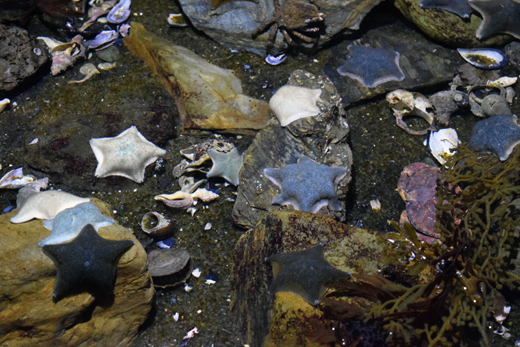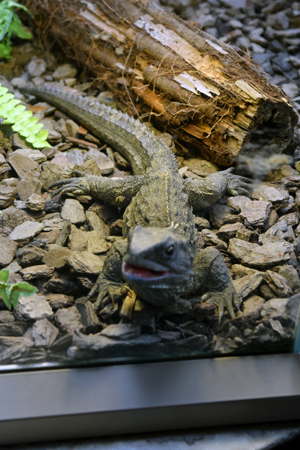
Editor’s Note: This is the 15th in a series of stories researched during Don and Nancy Harrison’s 50th Wedding Anniversary cruise from Sydney, Australia, to San Diego. Previous installments of the series, which runs every Thursday, may be found by tapping the number of the installment: 1, 2, 3, 4, 5, 6, 7, 8, 9, 10, 11, 12, 13, 14
By Donald H. Harrison

PICTON, New Zealand – Sure, the tuataras are the celebrities of EcoWorld Aquarium in Picton, a South Island venue of New Zealand from which ferries regularly depart for the City of Wellington on the North Island.
But for me, a most fascinating critter was a blue, six-legged cushion star that sat as a tiny minority of one among a tank full of five-legged cushion stars. I couldn’t resist naming the six-legged star “David.” I wondered if, when David chose what food to eat, he only closed the gelatinous mass that is his stomach over certain foods, rather than just any of them. At this spot in the tank where David was sitting, had he only just arrived, following a command like the ancient Abraham to “get thee to a place that I will show you” or did such a journey lay ahead of him?
Our guide said that if we searched the tank, we would also see a four-legged star. He suggested that both of these critters resulted from internal “programming errors.” Five-legged cushion stars normally are able to regenerate their legs, but the four-legged one may have experienced a failure to do so after one of its legs was lost. As for the six-legged cushion star, an apparent internal malfunction caused it to grow an extra leg.
I decided that our engaging and knowledgeable guide probably was right from the standpoint of biology, but wasn’t it also true that “programming errors” can be the impetus for the evolution of new species, perhaps even better adapted to changes in the environment than those that came before? And further, I mused, among human societies, hadn’t those persons with deviations—whether physical or behavioral—always been dismissed as “freaks” or, to use more modern, computer-savvy parlance, the result of “programming errors”?
Isn’t it also possible, I wondered, that those who break away from the norm might be intended for some other kind of life, such as the student who quits college to start something called “social networking,” or the man who on one sunny day starts to build an Ark?

Earlier in the tour of EcoWorld Picton Aquarium, our guide himself had implanted the idea that humans with 70 to 80 year lifespans have difficulty fathoming the world of creatures such as the tuatara which has an estimated life span of between 200 and 250 years. From our point of view, the tuatara—which is a kind of large spiny lizard native to New Zealand—does everything incredibly slowly; but, one supposes, from the tuatara’s point of view, humans seem to be always rushing around for no discernable purpose.
Two males were on display in a terrarium, one having recently emerged from a hollow log; the other lolling on a rock at the other side of the enclosure. “They don’t tend to do a lot,” said our guide. “They tend to sit around and be lazy. But in the grand scheme of things they are fighting for dominance. You can see the spines of this guy here; they are only about two-thirds the size of what they can be. When the two of them fight, they raise their spines, and puff them up, so that they look bigger and scarier. “
If, later in the day, the two were to come face to face, said our guide, it’s not likely that they would instantly start fighting. “It will be one hour of looking at each other, maybe moving around a bit, then another two hours of looking at each other, and so on. This is actually a lot of movement for a tuatara because they have very slow internal processes. There is not a lot going on. Sometimes they can have one heart beat every ten minutes; sometimes one every half hour. So, with not a lot going on inside, there’s not a lot going on outside. This contributes to their long lifespan; they are some of the longest-lived animals on the planet.”
Our guide said it’s not known exactly how long a tuatara actually lives. With some reptiles, there is an ear bone that has rings on it, similar to those on a tree, and after the reptile dies you can extract the bone and count the number of rings. However, tuataras don’t have ears , so that methodology won’t help for determining a tuatara’s age. In the city of Invercargill, at the southern end of South Island, “Henry the Tuatara” is believed to be 120 years old—in other words, middle aged—and “he didn’t start breeding until he was 111,” our guide said. “He picked himself a sprightly female of 93.”
If that male had been named “Abraham” instead of “Henry,” the female should be named “Sara,” I thought.
The tuataras at EcoWorld in Picton are about 30 years old, which is relatively young, our guide was saying. “This is one of three species of tuataras we have in New Zealand., and this one has only about 400 individuals left.” Of these only 40 are female. “When you have a low number of females it is difficult to do breeding programs,” he added. “The question is, why is there such gender disparity? The average temperature of the soil that the eggs are kept in determines the gender later on in life. Because we have global warming, we are getting higher temperatures, so that is why we are getting more males born than females born.”
The reason that two males are kept together, rather than a male and a female, is that “while the males are fighting for dominance, and neither is most dominant, the female won’t mate with either of them.” The female will wait to see which male is the stronger, which would give her the most offspring, he said.
While the two males battle, keeping the female in the terrarium with them “would put the female at risk; she might get caught in the crossfire, which would not be great because obviously we need all the females we can get,” he said.
Because the males are only 30 years old and so slow moving, “the fight could go on for 50 to 100 years, before it is decided” he said. Once a male’s dominance is determined, and a female is put into the enclosure with him, “it will take two to five years” before they successfully breed.
“So, it could be a century or more before we will be able to release any young into the wild,” said the guide. “The problem is that they are operating on a completely different time line than we are.”
If we think the life cycle of a tuatara is so long and so very deliberate, how much more so is the process of evolution? And even greater still is the timetable of the Almighty, about whom Moses speculated in Psalm 90: “For even a thousand years in Your eyes are but a bygone yesterday, and like a watch in the night.”
*
Harrison is editor of San Diego Jewish World. He may be contacted via donald.harrison@sdjewishworld.com
Pingback: Those special touches on a cruise ship | San Diego Jewish World
Pingback: John McCormick: A Kiwi friend of Israel | San Diego Jewish World